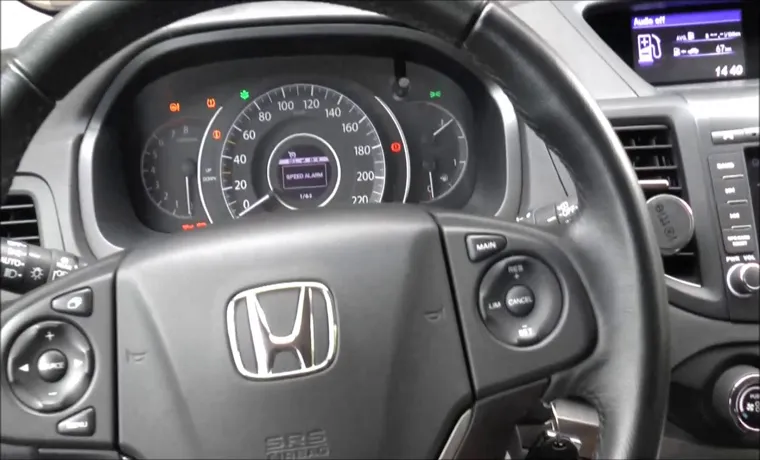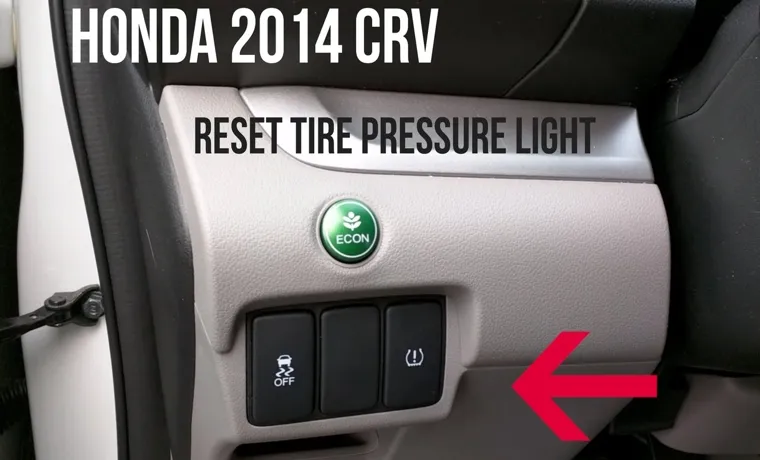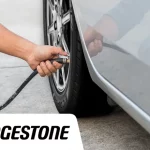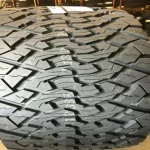Maintaining your Honda CR-V is essential for ensuring a safe and smooth driving experience. One aspect of vehicle maintenance that often goes overlooked is tire pressure. The appropriate tire pressure can boost fuel mileage, increase your car’s handling ability, and overall conserve the life of your tires.
Over or under-inflated tires may even lead to potential accidents. As a Honda CR-V owner, it’s crucial to check your tire pressure regularly. If you’re unsure how to go about checking tire pressure on your vehicle, don’t worry – it’s an effortless task that can be done in a mere few minutes.
In this blog, we’ll be taking you through the steps to check tire pressure on your Honda CR-V, so you can ensure your vehicle runs optimally. Keep reading to learn more!
Table of Contents
Why checking tire pressure is important
Knowing how to check the tire pressure of your Honda CR-V is crucial to ensure a smooth and safe driving experience. Properly inflated tires not only improve your vehicle’s handling and fuel efficiency, but they also prevent premature tire wear and reduce the risk of blowouts. The recommended tire pressure for your Honda CR-V can be found in the owner’s manual or on a sticker located on the driver’s side door jamb.
To check the tire pressure, you will need a tire pressure gauge. Simply remove the valve cap, press the gauge onto the valve stem, and take a reading. If the pressure is low, fill the tire with air until it reaches the recommended pressure.
Remember to check your tire pressure at least once a month and before long trips. Taking a few minutes to check your Honda CR-V’s tire pressure can save you from a dangerous situation on the road and increase the lifespan of your tires.
Avoid accidents and improve fuel efficiency
Checking your tire pressure may seem like a minor task, but it can have a significant impact on your driving experience. Not only does it ensure your safety on the road, but it also helps improve fuel efficiency and save you money in the long run. Properly inflated tires reduce the risk of accidents caused by tire blowouts, as it increases their longevity and traction on the road.
Furthermore, maintaining optimal tire pressure can increase your vehicle’s fuel economy and improve your overall driving experience. Inflated tires are essential for minimizing road resistance, which reduces fuel consumption, and ultimately saves you money on gas expenses. Therefore, it’s crucial to check your tire pressure regularly, especially before long trips, to ensure a safe and cost-efficient journey.
Keep in mind that over-inflated or under-inflated tires are just as dangerous as poorly-balanced ones, making it crucial to maintain the correct tire pressure for your vehicle.

How to gather the necessary tools
Checking the tire pressure of your Honda CR-V is easy as long as you have the right tools. Before you start, make sure you have a tire pressure gauge, an air compressor and a tire inflator. A tire pressure gauge is a small handheld tool used to measure the air pressure inside your tires.
It is important to have this tool handy so that you can accurately measure the pressure. An air compressor is used to inflate your tires if they are low on air. You can purchase a small portable air compressor that plugs into your car’s cigarette lighter or 12V power outlet.
This will come in handy if you ever need to inflate your tires on the go. Lastly, a tire inflator is used to attach to the compressor and inflate the tires. Make sure you have all of these tools ready before checking the tire pressure on your Honda CR-V.
By having the right tools for the job, you can quickly and easily check and inflate your tires as needed to ensure a safe and comfortable ride.
Tire pressure gauge and owner’s manual
When it comes to checking your tire pressure, having the right tools is essential. First, you’ll need a reliable tire pressure gauge. This nifty tool allows you to measure the air pressure in your tires quickly and accurately.
Make sure to choose a gauge that’s easy to read and has a pressure range that suits your specific needs. Next, you’ll want to consult your car’s owner’s manual. This valuable resource will help you determine the appropriate tire pressure for your vehicle.
It’s important to note that the recommended pressure may differ based on factors such as the type of tires you have installed or the load you’re carrying. By following these simple steps and using the right tools, you can ensure that your tires are inflated to the proper level, which can improve your vehicle’s handling, fuel efficiency, and overall safety on the road.
Prepare your Honda CR-V for the check-up
Honda CR-V owners need to ensure that they check their tire pressure regularly. Checking your tire pressure is vital, not just for your safety, but also for the longevity of your tires. Low tire pressure can affect your car’s performance by reducing your fuel efficiency, causing tire wear, and even making your vehicle harder to handle.
Fortunately, checking the tire pressure on your Honda CR-V is quite simple. First, you need to ensure that your tires are cold to get an accurate reading. Next, locate the tire pressure monitoring system (TPMS) reset button, typically found in the glove box or on the dashboard.
Press the button until the TPMS light on your dash flashes, indicating that you are in reset mode. Finally, use a tire pressure gauge to check the pressure on each tire, ensuring that they match the recommended PSI in the owner’s manual. By taking simple steps like these, Honda CR-V owners can ensure their car runs efficiently, and they stay safe on the road.
Wait until tires are cold and park in a level surface
When it’s time for your Honda CR-V’s check-up, it’s important to prepare your vehicle to ensure an accurate diagnosis. One key step is to wait until the tires are cold before bringing your car in. When tires are hot, they expand and can give an incorrect reading on the pressure gauge.
Additionally, it’s important to park on a level surface to ensure a consistent reading. This will allow the mechanic to properly inspect your tires and measure the tread depth, as well as check your wheel alignment. By taking these simple steps before your appointment, you can help ensure that your Honda CR-V receives the best possible care.
So, next time you’re scheduled for a check-up, remember to wait for cold tires and park on a level surface for a smooth and accurate diagnosis.
Locating the tire pressure monitoring system
If you own a Honda CR-V and are unsure how to check your tire pressure, don’t worry, it’s easy. First, you need to locate the tire pressure monitoring system, which is typically found in the instrument cluster of your car. On the CR-V, it’s located in the center of the cluster and can be accessed via the Multi-Information Display (MID).
Once you’ve found it, press the “Menu” button on the steering wheel until “Tire Pressure” is highlighted. From there, you can view the current tire pressures for each tire and fill them to the recommended pressure levels. It’s important to check your tire pressure regularly, as improperly inflated tires can lead to decreased fuel efficiency, increased tire wear, and even blowouts while driving.
So take a few minutes every month to check your tire pressure and keep your CR-V running smoothly on the road.
Dashboard and door jamb instructions
When it comes to maintaining your vehicle’s tires, keeping an eye on the tire pressure is crucial for both safety and performance. The tire pressure monitoring system (TPMS) can be easily located in your dashboard or door jamb, depending on the make and model of your car. On most vehicles, the TPMS icon appears as an exclamation point inside a tire on the dashboard, alerting you when the tire pressure is low.
But if you’re having trouble finding the TPMS, don’t worry – it might be in the door jamb instead. Look for a sticker indicating the recommended tire pressure, and you’ll likely find the TPMS information nearby. Keep in mind that TPMS sensors can sometimes malfunction, so it’s always a good idea to check your tire pressure manually every few months, especially during extreme weather conditions.
Your car’s manual should have more specific instructions on how to locate and maintain your TPMS. By keeping an eye on your tire pressure and taking care of your TPMS, you’ll be ensuring a smoother, safer ride for years to come.
Checking the tire pressure
If you own a Honda CR-V, keeping an eye on your tire pressure is crucial for your safety and the longevity of your tires. Checking the tire pressure is a simple task that you can easily perform at home. First, locate the recommended tire pressure in the owner’s manual or on the sticker located on the driver’s side door jamb.
Next, remove the valve cap from each tire and use a tire pressure gauge to check the pressure. If the pressure is lower than recommended, use an air compressor or visit a gas station with an air pump to fill them to the correct level. On the other hand, if the pressure is too high, remove some air using the gauge until it reaches the recommended level.
Regularly checking your tire pressure can also improve your vehicle’s fuel efficiency and prevent uneven wear of the tires. Make sure to check your tire pressure at least once a month and before embarking on a long road trip to ensure your safety on the road.
Using the tire pressure gauge and adjusting if necessary
Checking the tire pressure is an important step in ensuring your vehicle stays in good condition and is safe to drive. One of the tools you’ll need for this task is a tire pressure gauge. This instrument is used to measure the amount of air pressure in your tires.
To use the tire pressure gauge, first, you need to remove the valve cap from the tire valve stem. Then, place the gauge onto the valve stem and press down firmly. The gauge will give you a reading of the tire pressure in PSI (pounds per square inch).
If the reading is lower or higher than the manufacturer’s recommended PSI for your vehicle, you’ll need to adjust the pressure accordingly. Underinflated tires can cause poor fuel economy and tire wear, while overinflated tires can lead to blowouts. It’s essential to make sure your tire pressure is within the recommended range to ensure optimum performance and safety on the road.
Therefore, checking your tire pressure regularly is crucial for both your car and your well-being.
What to do after the check-up is finished
After you have finished checking the tire pressure on your Honda CR-V, you might wonder what else you can do to make sure your vehicle stays in good condition. One thing you could do is to inspect your tires for any signs of wear or damage, such as cracks, punctures, or bulges. You should also make sure the tread is at a safe depth, as worn out tires can be a safety hazard and reduce your vehicle’s performance.
Another important maintenance task is to check your oil and other fluid levels, such as coolant, brake fluid, and power steering fluid. These fluids are crucial to the proper operation of your vehicle and can damage your engine or other components if they are low or dirty. Finally, you can also inspect other parts of your vehicle, such as the brakes, suspension, and steering, for any signs of wear or damage that may need attention.
By staying proactive and addressing any issues early on, you can help ensure that your Honda CR-V stays safe and reliable for years to come.
Reinflate or deflate tires if necessary and reset the monitoring system
After your vehicle’s check-up is finished, it’s important to take a few additional steps to ensure everything is in tip-top shape. One of the essential tasks is to check and adjust your tire pressure as necessary. Your car’s monitoring system can help you identify any issues, but it’s always a good idea to visually inspect the tires as well.
If you notice any abnormal wear or damage, it’s best to have them replaced. Replacing your tires may seem like a hassle, but it’s a crucial safety measure that can prevent accidents. Additionally, don’t forget to reset your tire monitoring system once the tire pressure is adjusted to ensure you receive accurate readings.
By taking these steps, you can drive confidently and safely on the road. So, don’t forget to check your tires after your car’s check-up for optimal performance and safety.
Conclusion
In the world of automobiles, checking your tire pressure is one of those things that may not seem important, but can actually make a huge difference in your driving experience. With the Honda CR-V, checking your tire pressure is a cinch, and it can help you achieve the perfect balance of fuel efficiency, safety, and road comfort. So don’t neglect your tire pressure – take a cue from your trusty Honda CR-V and give those tires the attention they deserve!”
FAQs
What is the recommended tire pressure for Honda CR-V?
The recommended tire pressure for Honda CR-V is 32 psi.
How often should I check my Honda CR-V’s tire pressure?
It is recommended to check your Honda CR-V’s tire pressure at least once a month and before long trips.
Can I check my Honda CR-V’s tire pressure at a gas station?
Yes, you can check your Honda CR-V’s tire pressure at a gas station using the air pump.
How do I know if my Honda CR-V’s tire pressure is too low?
If your Honda CR-V’s tire pressure is too low, you may notice decreased fuel efficiency, irregular wear on the tires, and poor handling and braking performance.
Is it safe to drive if my Honda CR-V’s tire pressure is low?
It is not recommended to drive if your Honda CR-V’s tire pressure is significantly low as it can damage the tires, affect the vehicle’s handling, and cause an accident.
Can overinflating my Honda CR-V’s tires be harmful?
Yes, overinflating your Honda CR-V’s tires can increase the risk of a blowout, decrease the tire’s lifespan, and affect the vehicle’s handling.
How can I maintain the proper tire pressure in my Honda CR-V?
You can maintain the proper tire pressure in your Honda CR-V by regularly checking the tire pressure, adjusting it as needed, and keeping the tires inflated to the recommended level.



